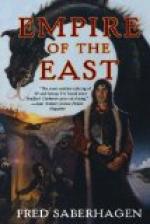We stood for some minutes in utter silence, and then followed the lead of the doctor, who approached the coffin and kissed the crucifix, which a priest gave to us all in turn: a plate for alms lay on the vestments: then the woodwork of the shrine was likewise kissed, and we emerged again into the narrow gallery.
The heat had been intense in the little chapel, and we were in that limp and exhausted state that one experiences in a Turkish bath.
[Illustration: THE UPPER MONASTERY]
The gallery was open on one side where a large bell was fixed, and this our puny guide struck four times vigorously in the sign of a cross without a word of warning.
After the impressive solemnity and silence of the preceding minutes, we nearly jumped out of our skins, and when our injured hearing had sufficiently recovered so that we could distinguish the sound of our own voices, we demanded an explanation of this apparently childish and wanton outrage.
He said that he had struck the bell for the renewal of his strength. It appeared an unnecessary request.
Dr. S. explained that pilgrims strike the bell on emerging from the shrine, praying for some special benefit.
We next went up a lot of steps to a platform under the shelving cliff where there was a beautiful spring of water. The view which it commanded was magnificent. Below us lay the lower monastery and the deep valley of the Zeta, the mountains rising again sharply on the further side; to the right and left stretched wooded slopes.
Then we descended again and paid the priest a visit. This man, over eighty years of age, has spent forty years of his life as a hermit in that rocky crag. With the exception of Whitsuntide and the occasional visits of pilgrims, he lives entirely alone, subsisting on vegetables. His appearance was most patriarchal, his snowy white beard and saintly look impressing us greatly. When he heard that we were from England, he embraced and kissed us repeatedly, much to our embarrassment. His joy knew no bounds, and he kept us with him in his rock-hewn cell for a considerable time. He even consented to be photographed, for the first time in his life, facing the ordeal with unflinching courage.
The descent to the lower monastery was made in record time, and with half-closed eyes. We found the Archbishop standing in the shade of an enormous tree surrounded by a large ring of Montenegrins. He beckoned to us, asking us for our impressions, and needless to say we solemnly drank coffee. This beverage began to pall before we left Montenegro.
After partaking of a splendid meal (for the country), washed down with wine such as is not to be obtained elsewhere in the land, we paid a farewell visit to His Grace and departed.
Already the booths were fast disappearing and a mere handful of peasants remained. Many pilgrims journey from seven to eight days on foot or on horseback to Ostrog, over mountain passes and barren regions; so that the pilgrimage is very real.




